 |
 |
 |
| |
Treatment of Chronic Hepatitis C with Telaprevir (TVR) in Combination with Peginterferon Alfa-2a with or without Ribavirin: Interim Results of the PROVE2 Study
|
| |
| |
Reported by Jules Levin
43rd EASL Conference, April 23-27, 2008, Milan, Italy
GM Dusheiko, C Hezode, S Pol, T Goeser, J-P Bronowicki, M Bourtiere, P Buggisch, L Serfaty, T Berg, P Couzigou, Y Benhamou, N Forestier, L Bengtsson, S Gharakhanian, R Kauffman, J Alam, P Ferenci, J-M Pawlotsky, S Zeuzem
On Behalf of the PROVE2 Study Team (France, Germany, Austria, USA, UK)
AUTHOR SUMMARY OF RESULTS
Interim Data
Patients with HCV genotye 1 infection achieved:
-- 68% SVR in the 24-week TVR-based treatment arm
-- 62% SVR in the 12-week TVR-based treatment arm
-- 48% response rate at 12-week followup point in the control arm
Response rates were higher in the TVR-based treatment arms containing ribavirin as compared to the non-ribavirin and control arms.
Adverse events reported more frequently than placebo were: skin (rash, pruritis) and anemia
-- other adverse events were similar in type and frequency to those seen with Peg-IFN/RBV
-- 13% of patients in the TVR-based treatment arms versus 10% in the control arm discontinued treatment due to adverse events
AUTHOR CONCLUSIONS
Telaprevir in comination with Peg-IFN/RBV demonstrated significantly higher SVR rates compared with standard therapy in patients infected with HCV genotype 1, with the potential to shorten the overall treatment duration
Favorable risk/benefit profile supports further evaluation in the ongoing phase 3 study.
This regimen may lead to a new treatment approach for HCV genotype 1-infected patients.
OBJECTIVES
Compare SVR rates achieved with TVR-based therapy in treatment-naive HCV genotype 1 patients versus Peg-IFN/RBV
Assess the safety and tolerability o TVR-based treatment
Randomized, controlled, Phase 2b clinical trial
--323 treatment-naive, HCV genotype 1 patients
--28 centers in Europe
--4 arm comparative study (1:1:1:1 randomiztion)
STUDY DESIGN
PR48: placebo + Peg/RBV for 12 weeks; Peg/RBV 36 additional weeks
T12/P12: TVR + PegIFN for 12 weeks; followup 24 additional weeks
T12/P12: TVR + Peg/RBV for 12 weeks; 24 additional weeks followup.
T12/PR24: TVR + Peg/RBV; Peg/RBV for 12 additiona weeks; followup for 24 additional weeks
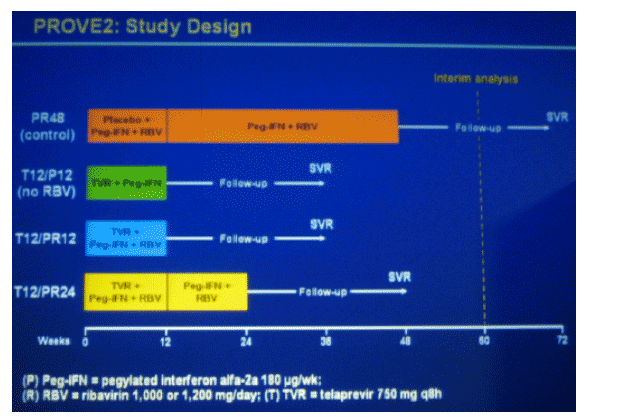
METHODS
Primary Endpoint:
Proportion of patients achieving SVR, defined as undetectable HCV RNA (LOD 10 IU/mL Taqman assay 24 weeks after end of dosing
Patients:
--treatment-naive
--infected with HCV genotype 1
--patients with cirrhosis were excluded
Statistical Analysis:
--ITT analysis included all randomized patients who received at least one dose of study drug
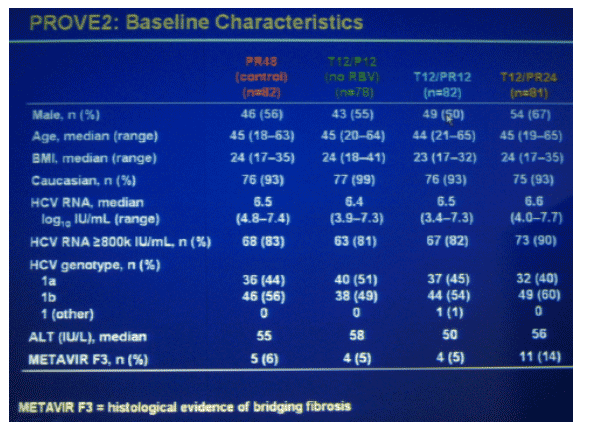
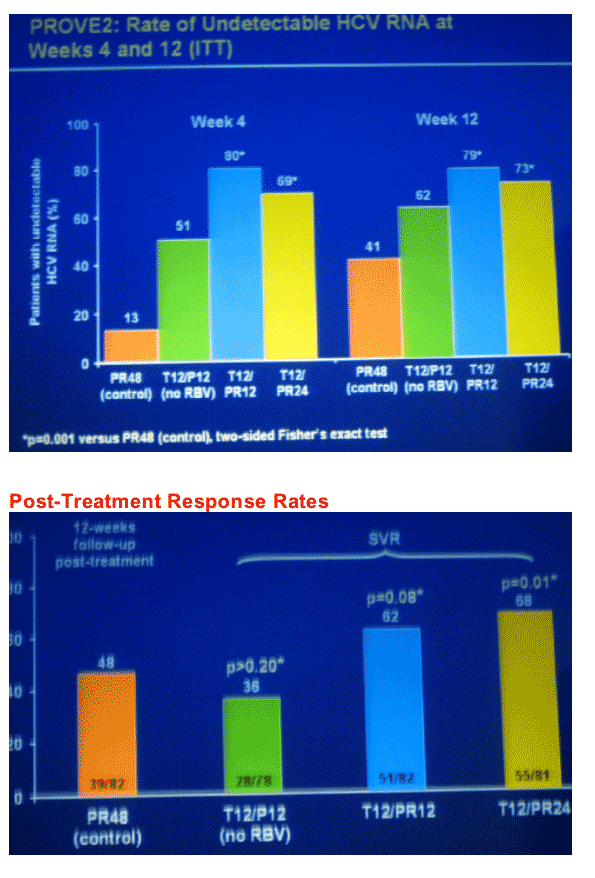
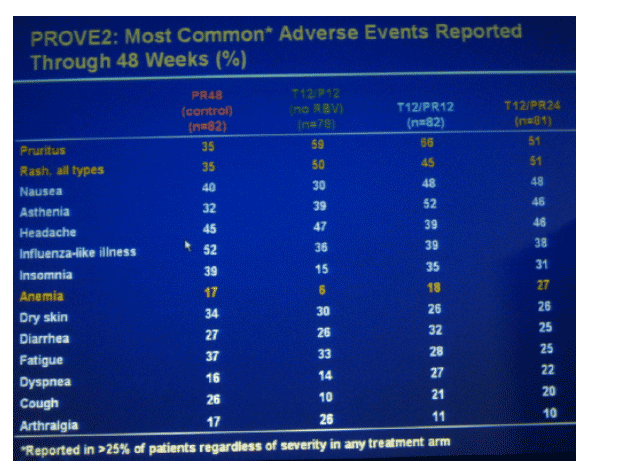
RELAPSE RATES
PR48: 20% (control)
T12/P12 (no RBV): 48%
T12/PR12: 28%
T12/PR24: 14%
Relapse rate in patients receiving T12/P24 with 4-week and 12-week undetectable HCV RNA was 7% (3/48).
After 12-week followup post-treatment.
Data shown are number of patients with reapse / number of patients with HCV RNA <10 IU/mL at end-of-treatment who met viral response criteria.
VIROLOGIC BREAKTHROUGH at Week 12
T12/P12 (no RBV): 28%
T12/P12 and T12/P24 combined 2%
Virologic breakthrough was defined based on the criteria below in patients who were on treatment:
-- >1 log increase above HCV RNA nadir or
-- HCV RNA > 100 IU/mL in patients with previously undetectable HCV RNA
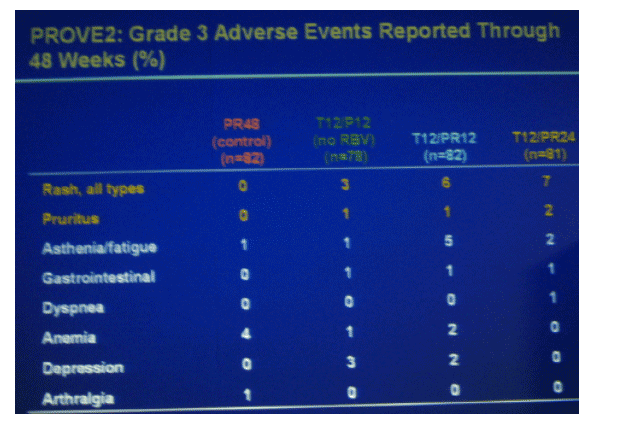
SAFETY OBSERVATIONS: TREATMENT DISCONTINUATION
Discontinuations for adverse events:
-- 10% each in the control and T12/P12 arms
-- 12% and 16% in the 12- and 24-week T/PR arms (T12/PR12 and T12/PR24),
respectively
In the T/PR arms, rash was the most common reason for premature treatment discontinuation:
-- 7% (12 of 163) discontinued for rash in these arms
-- Maculo-papular rash typical of drug reaction
-- Investigators reported resolution upon discontinuation of treatment
-- Median time from treatment initiation to discontinuation of all study drugs was about 9 weeks
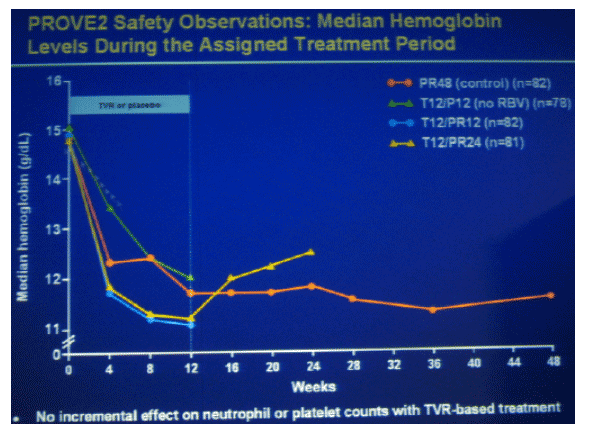
|
| |
|
 |
 |
|
|